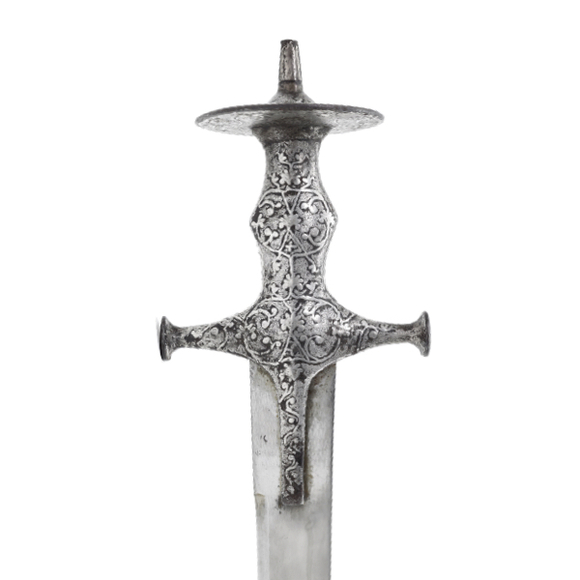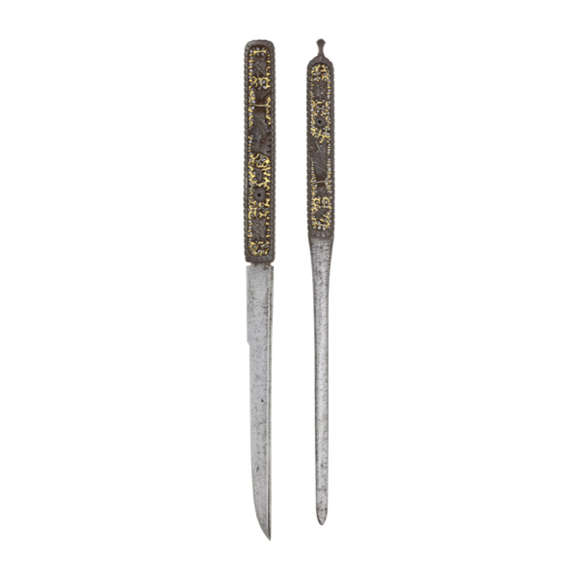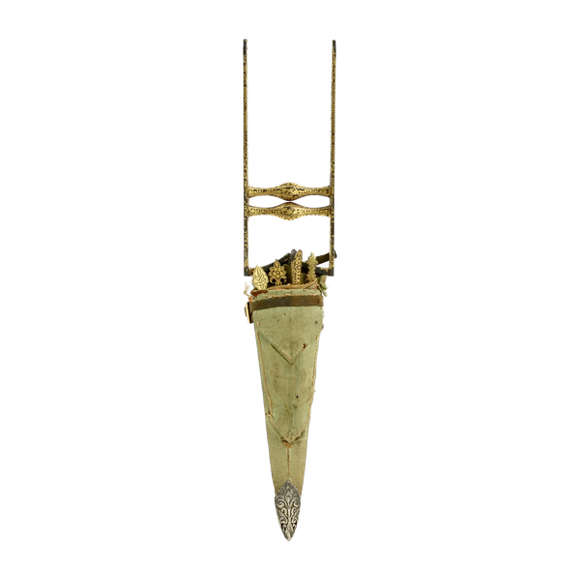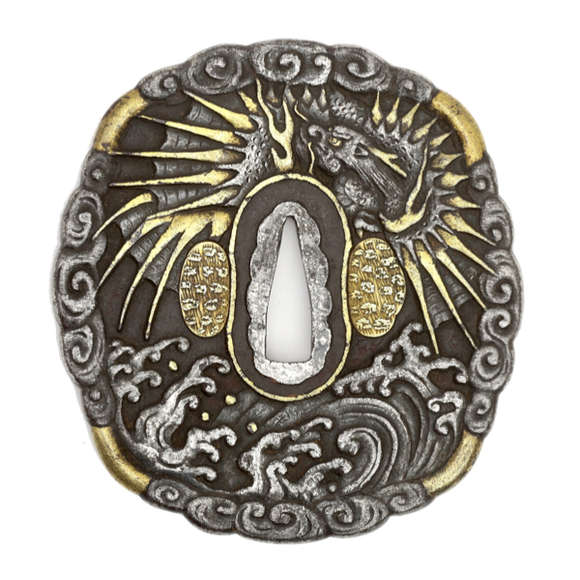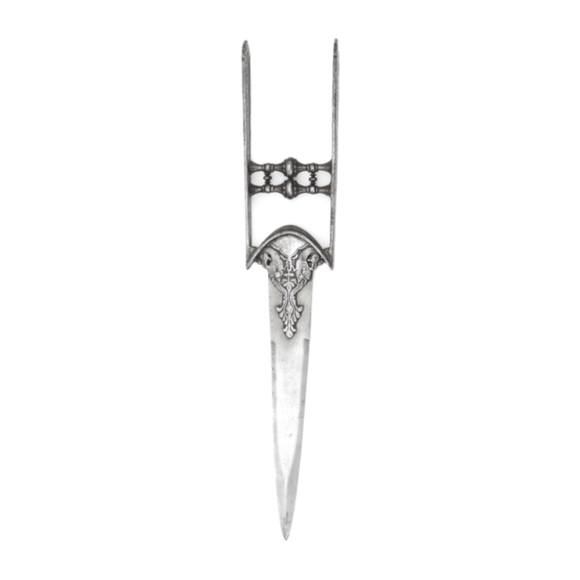The hilt is in the typical Marwari Rajput style, made by Ram Namar in 1857 A.D.

44.5 cm
22.6 cm
Base 9.5 mm
Thickest 16.5 mm
Base 36 mm
At thickest point 24 mm
479 grams
At hilt-blade junction
Iron, steel, gold
General area of Bundelkhand
North India
18th to early 19th century
From a Scandinavian collection
Description
A heavy armor piercing katar.

The narrow blade thickens so much as to reach a perfectly square cross-section at its thickest. The grooves are very deeply cut. Grooves on blades are often called "blood grooves" in the assumption they are to drain blood but this is usually not the case. Their first and foremost function is to lighten the weapon while maintaining rigidity. In this case they are so deep that they could indeed act as blood channels. Perhaps these heavy armor piercers are made this way because they are more likely to get stuck in a steel plate.
The hilt with the narrow but relatively thick side-bars and three thin handle bars that protrude at the sides. It is decorated with gold koftgari overlay, slightly differing on either side. One side shows a series of stripes that could be interpreted as stylized tiger stripes or leaves of the Tree of Life often seen on northern katar. The other side has more geometric decoration.
The sides of the sidebars are left plain, probably to once show off their steel construction which may well contain wootz. In current condition, only grey steel can be seen. Both tips are decorated with stylized flowers in gold.
Geographical attribution
This katar is part of a group that share a number of characteristics:
1. A handle with multiple slender bars, whose ends protrude on the outside of the sidebars.
2. The sidebars are comparatively narrow but thick, with rounded ends.
3. Blades are often quite narrow but very thick with deep sunken panels and an exaggerated thickening at the tip.
Working from examples with provenance, I've pieced together a likely place of origin for them:
A number of these are published in Nordlunde, Jens: A Passion for Indian Arms; a Private Collection. For similar handles and characteristic narrow blades, see catalog numbers 55, 65, 134, 157.1 For similar handles, see catalog numbers 112 (dated 1803-1804), 46. Number 112 bears an inscription attributing it to Bakthwar Singh, the second ruler of Ulwar.
Another hint to their attribution can be found in Arms and Armour at Sandringham. Two examples with identical handles but with three blades each are said to have been presented by "the Jagirdar of Alipura, Bundelkhand".2
A geometrically identical example can be found in Indian art in Marlborough House. According to its description, this example is gilded. No geographical attribution is given.3
An example with a curved blade can be found in the Royal Armories in Leeds, accession number: XXVID.97 It is said to be from Gwalior, a town with a strategic fortress at the edge of Bundelkhand. It's 250 km southeast of Ulwar and about the same distance northwest of Alipura. The Rajput states of Ulwar and Bundelkhand shared a stretch of border in central North India, with the Mahratta states to the south.
And finally, Hendley illustrates one such katar in the armory of H.H. the Nawab of Tonk.4
Tonk lies in the West of Rajasthan.
Let's plot that out on a map:
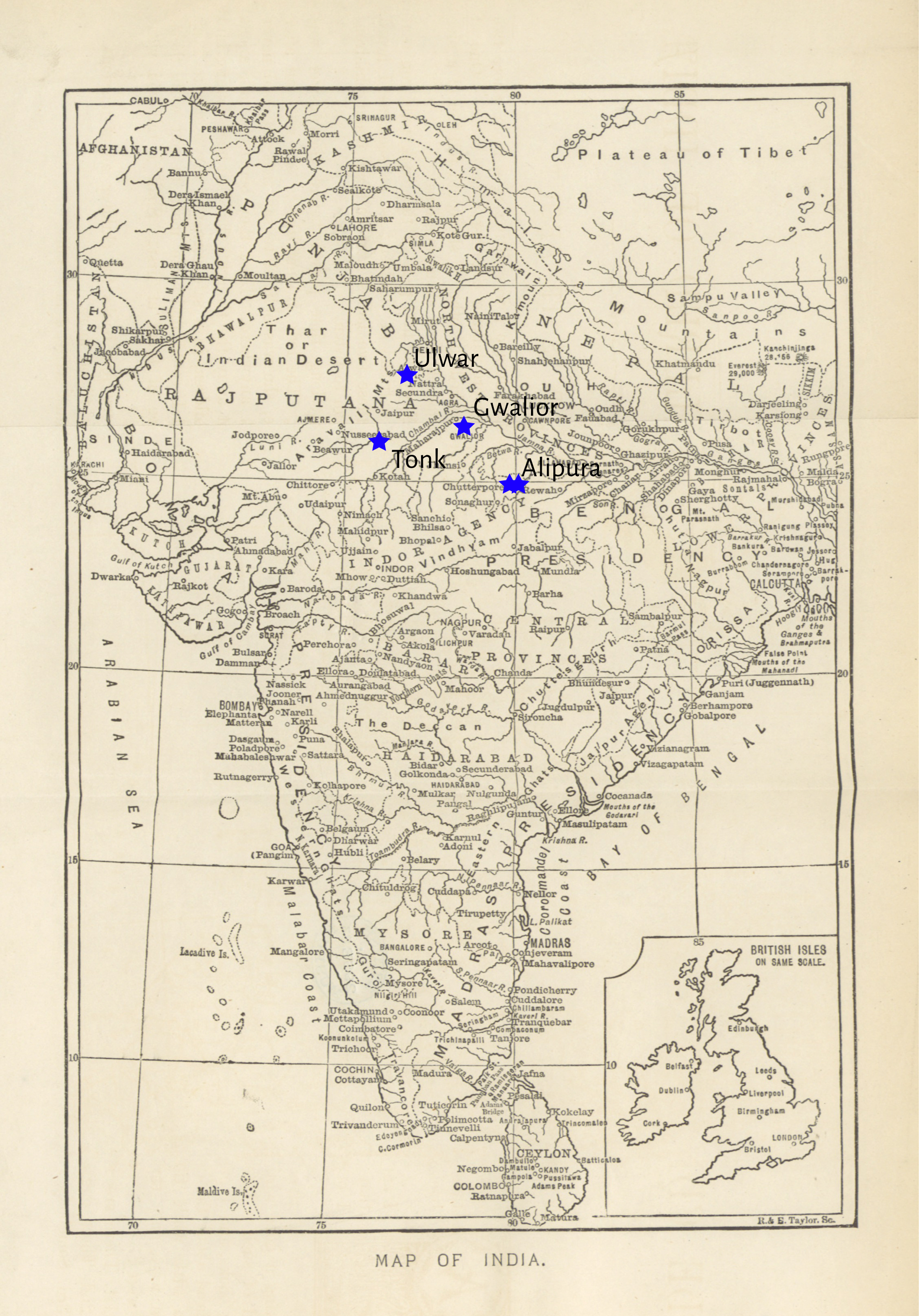
All seem to originate from the general area of Bundelkhand and the easternmost part of the kingdom of Ulwar.
A southern example
Another katar worth mentioning is in the Metropolitan Museum, accession number 36.25.753. It shares the protruding handle bars of the preceding examples but breaks the mold in some important ways: The blade is wider and wavy, and the whole is chiseled in a southern style. It is currently attributed to Tanjore, but I doubt that as it would be the first Tanjore katar I am aware of with a one-piece construction. Normally, katar from this area have a separate blade held with rivets between two langets protruding from the hilt. One piece construction katar appear in the Deccan and north of that, and it is known that one-piece constructed katar in a quasi southern style have been produced in the south of Rajasthan as well.5 It is an interesting outlier.
NOTES
1. Nordlunde, Jens: A Passion for Indian Arms; a Private Collection. 2016, Denmark. Self-published.
2. Indian art in Marlborough House. A catalogue of the Collection of Indian Arms and Objects of Art presented by the Princes and Nobles of India. Illustrated and printed by W. Griggs. Photo and Chromo-Lithographer to Her Majesty the Queen. Reprint. Ken Trotman, 2008.
3. Arms and armour at Sandringham. The Indian Collection presented by the Princes, Chiefs and Nobles of India in 1875-1786; also weapons and war relics from other cultures. London: W. Griggs & Sons, Ltd, Hanover Street, Peckham, 1910. Catalog numbers 20 and 21.
4. Thomas Holbein Hendley; Memorials of the Jeypore exhibition. Volume II. 1883. Plate XXXVI.
5. See Thomas Holbein Hendley; Damascening on steel or iron as practiced in India. W. Griggs & Sons, Ltd. London 1892. Plate 25, a.















The only set of its type known to me in both private and museum collections.
Of a style often associated with Tanjore, the seat of the Vijayanagara empire.

